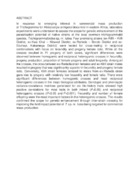| dc.contributor.author | Baya, Joseph M. | |
| dc.contributor.author | Sithanantham, S. | |
| dc.contributor.author | Gitonga, Linus | |
| dc.contributor.author | Osir, Ellie | |
| dc.date.accessioned | 2024-02-19T13:12:54Z | |
| dc.date.available | 2024-02-19T13:12:54Z | |
| dc.date.issued | 2007-09 | |
| dc.identifier.citation | Biocontrol Science and Technology Volume 17, 2007 - Issue 7 | en_US |
| dc.identifier.uri | DOI:10.1080/09583150701488669 | |
| dc.identifier.uri | https://doi.org/10.1080/09583150701488669 | |
| dc.identifier.uri | https://karuspace.karu.ac.ke/handle/20.500.12092/3048 | |
| dc.description | Scope for genetic enhancement of the parasitisation potential | en_US |
| dc.description.abstract | In response to emerging interest in commercial mass production of Trichogramma for Helicoverpa armigera biocontrol in eastern Africa, laboratory experiments were undertaken to assess the scope for genetic enhancement of the parasitisation potential of native strains of the local common trichogrammatid species, Trichogrammatoidea sp. nr. lutea. Four promising strains (ex-Kilifi – Kilifi District, ex-Kwa Chai – Kibwezi District, ex-Rarieda – Bondo District and ex-Ebuhayi, Kakamega District) were tested for cross-mating in reciprocal combinations with focus on fecundity and progeny female ratio. While all the crosses resulted in F1 progeny of both sexes, significant differences were observed between homogamic and reciprocal heterogamic crosses in fecundity, progeny production, proportion of female progeny and adult longevity. Among all the crosses, the cross between ex-Rarieda strain females and ex-Kilifi strain males resulted in progeny that was significantly superior in fecundity and progeny female ratio. Conversely, Kilifi strain females crossed to males from ex-Rarieda strain gave rise to progeny with relatively low fecundity and female ratio. There were significant differences between homogamic crosses and most reciprocal heterogamic crosses in the major biological attributes. Genotypic and phenotypic variance-covariance matrices generated for six life-history traits showed high positive correlations for most traits in both inbred (P<0.05) and reciprocal heterogamic crosses (P<0.05 and P<0.001). Fecundity and number of female offspring were the most important factors in the heterogamic crosses. The results confirmed the scope for genetic enhancement through inter-strain crossing for improving the field impact potential of T. sp. nr. lutea being targeted for commercial mass production. | en_US |
| dc.language.iso | en | en_US |
| dc.publisher | Taylor & Francis | en_US |
| dc.subject | Biological control | en_US |
| dc.subject | Trichogrammatoidea sp. nr. lutea | en_US |
| dc.subject | cross-mating | en_US |
| dc.subject | genetic enhancement | en_US |
| dc.title | Scope for genetic enhancement of the parasitisation potential of four native strains of Trichogrammatoidea sp. nr. lutea Girault (Hymenoptera: Trichogrammatidae | en_US |
| dc.type | Article | en_US |
